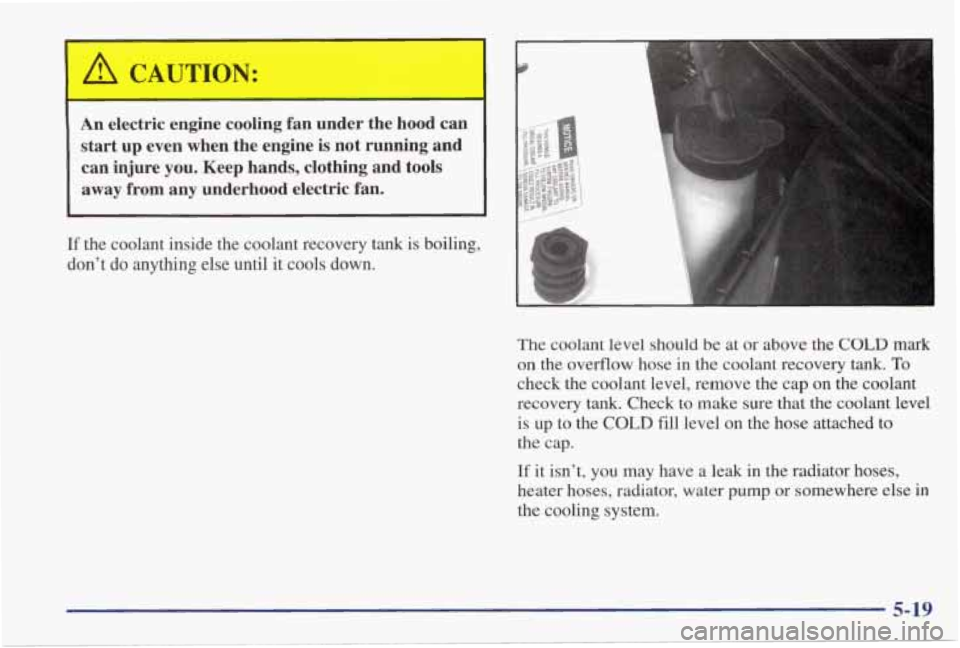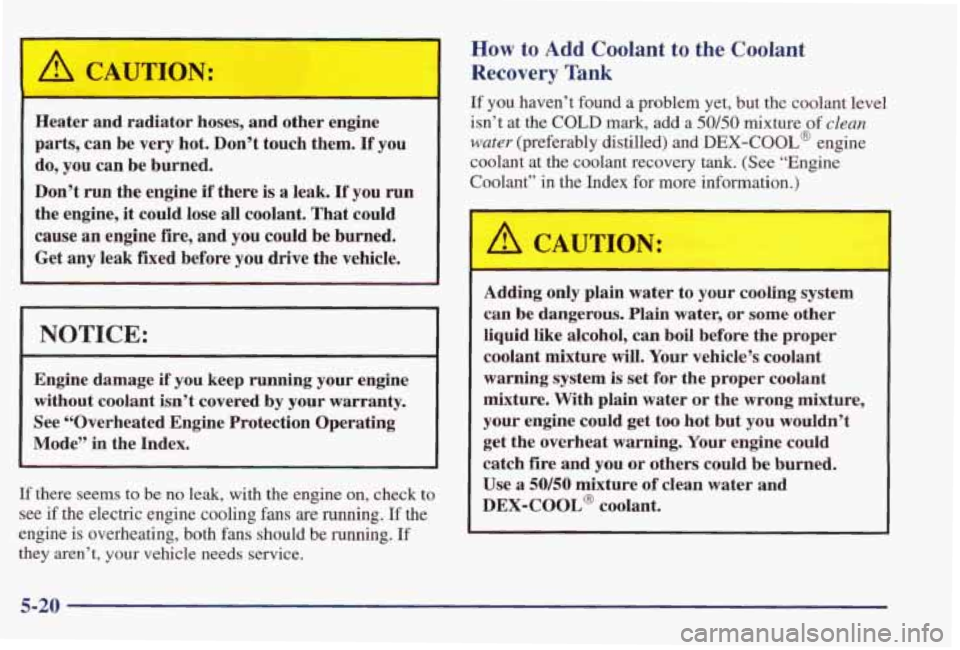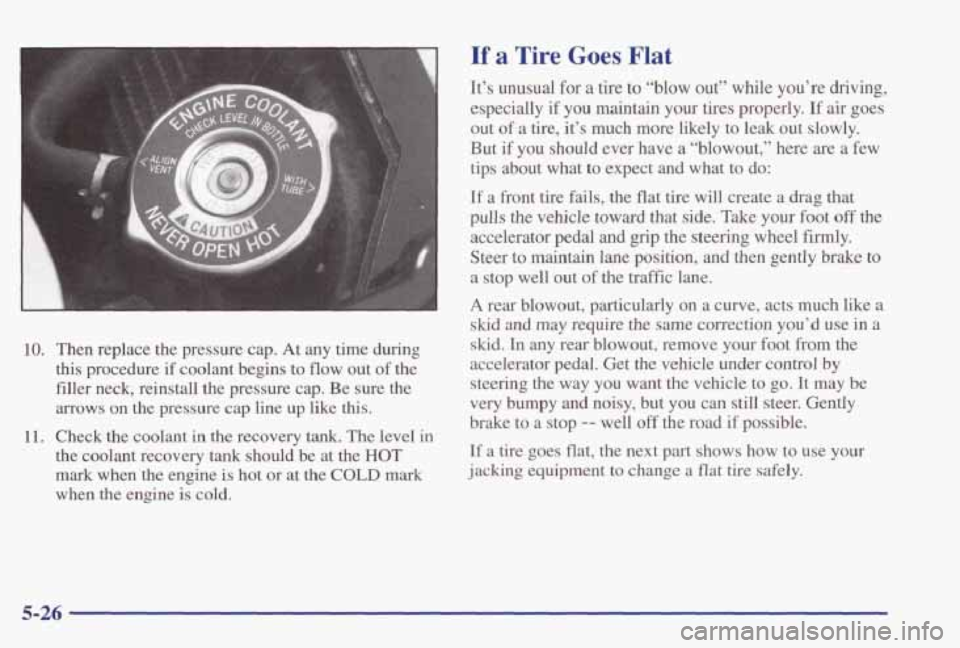1998 PONTIAC GRAND PRIX coolant level
[x] Cancel search: coolant levelPage 96 of 402

How long should you keep the coolant heater plugged
in? The answer depends on the outside temperature, the
kind of oil you have, and some other things. Instead of
trying to list everything here, we ask that you contact
your dealer in the area where you’ll be parking your
vehicle. The dealer can give you the best advice for that
particular area.
Automatic Transaxle Operation
I ‘%
6
10
Your automatic transaxle may have a shift lever on the
steering column or on the console between the seats.
Maximum engine speed is limited when you’re in
PARK (P) or NEUTRAL (N), to protect driveline
components from improper operation. There are several different positions
for your shift lever.
PARK
(P): This locks your front wheels. It’s the best
position to use when you start your engine because your
vehicle can’t move easily.
It is dangerous to get out of your vehicle if the
shift lever
is not fully in PARK (P) with the
parking brake firmly set. Your vehicle can roll.
Don’t leave your vehicle when the engine
is
running unless you have to. If you have left the
engine running, the vehicle can move suddenly.
You or others could be injured. To be sure your
vehicle won’t move, even when you’re on fairly
level ground, always set your parking brake and
move the shift lever to PARK
(P).
See “Shifting Into PARK (P)” in the Index. If
you’re pulling a trailer, see “Towing a Trailer” in
the Index.
2-21
Page 148 of 402

The oil level monitoring system only checks oil level during the brief period between key on and engine
crank. It
does not monitor engine oil level when the
engine is running. Additionally, an oil level check is
only performed if the engine has been turned
off for a
considerable period of time, allowing the oil normally in
circulation to drain back into the oil pan.
Engine Coolant Temperature Light
TEMP
This light tells you that your
engine coolant has
overheated or your radiator
cooling fan
is not working.
If you have been operating your
vehicle under normal
driving conditions, you should pull
off the road, stop
your vehicle and turn
off the engine as soon as possible.
In “Problems on the Road,” this manual shows what to
do. See “Engine Overheating” in the Index.
Engine Coolant Temperature Gage
You have a gage that shows
the engine coolant
temperature. If the gage
pointer moves into
the red
area, your engine is too hot!
That reading means the sarne thing as the warning light.
It means
that your engine coolant has overheated. If you
have been operating your vehicle under normal driving
conditions, you should pull
off the road, stop your
vehicle and turn
off the engine as soon as possible.
In “Problems on the Road,”
this manual shows what to
do. See “Engine Overheating” in the Index.
2-73
Page 254 of 402

’ A CAUTION:
An electric engine cooling fan under the hood can
start up even when the engine is not running and
can injure you. Keep hands, clothing and tools
away
from any underhood electric fan.
If the coolant inside the coolant recovery tank is boiling,
don’t do anything else until it
cools down.
The coolant level should be at or above the COLD mark
on the overflow hose
in the coolant recovery tank. To
check the coolant level, remove the cap on the coolant
recovery tank. Check to make sure that the coolant level
is up to the COLD fill level on the hose attached to
the cap.
If it isn’t,
you may have a leak in the radiator hoses,
heater hoses, radiator, water pump or somewhere else in
the cooling system.
5-19
Page 255 of 402

I A CAUTION: I
Heater and radiator hoses, and other engine
parts, can be very hot. Don’t touch them.
If you
do, you can be burned.
Don’t run the engine
if there is a leak. If you run
the engine, it could lose all coolant. That could
cause
an engine fire, and you could be burned.
Get any leak fined before you drive the vehicle.
NOTICE:
Engine damage if you keep running your engine
without coolant isn’t covered by your warranty.
See “Overheated Engine Protection Operating
Mode” in the Index.
If there seems to be no leak, with the engine
on, check to
see if the electric engine cooling fans are running. If the
engine is overheating,
both fans should be running. If
they aren’t, your vehicle needs service.
How to Add Coolant to the Coolant
Recovery Tank
If you haven’t found a problem yet, but the coolant level
isn’t at the
COLD mark, add a 50/50 mixture of clean
wuter (preferably distilled) and DEX-COOL@ engine
coolant at the coolant recovery tank. (See “Engine
Coolant”
in the Index for more information.)
Adding only
plain water to your cooling system
can
be dangerous. Plain water, or some other
liquid like alcohol, can boil before the proper
coolant mixture
will. Your vehicle’s coolant
warning system
is set for the proper coolant
mixture. With plain
water or the wrong mixture,
your engine could get too hot but you wouldn’t
get the overheat warning. Your engine could
catch fire and you or others could
be burned.
Use
a 50/50 mixture of clean water and
DEX-COOL@ coolant.
5-20
Page 260 of 402

6. Then fill the coolant recovery tank to the
7. Put the cap back on the coolant recovery tank, but
FULL mark.
leave the radiator pressure cap
off.
‘f
8.
9.
Start the engine and let it run until you can feel the
upper radiator hose getting hot. Watch out for
the
engine cooling fans.
By this time, the coolant level inside the radiator
filler neck may be lower. If the level
is lower, add
more of the proper DEX-COOL@ coolant mixture
through the filler neck until the level reaches the
base
of the filler neck.
5-25
Page 261 of 402

10. Then replace the pressure cap. At any time during
this procedure if coolant begins to flow out of the
filler neck, reinstall the pressure cap. Be sure the
arrows on the pressure cap line up like this.
11. Check the coolant in the recovery tank. The level in
the coolant recovery tank should be at the
HOT
mark when the engine is hot or at the COLD mark
when the engine
is cold.
If a Tire Goes Flat
It’s unusual for a tire to “blow out” while you’re driving,
especially if
you maintain your tires properly. If air goes
out
of a tire, it’s much more likely to leak out slowly.
But if
you should ever have a “blowout,” here are a few
tips about what to expect and what to do:
If a front tire fails, the flat tire will create a drag that
pulls the vehicle toward that side. Take your foot
off the
accelerator pedal
and grip the steering wheel firmly.
Steer to maintain lane position,
and then gently brake to
a stop well out of the tr&k lane.
A rear blowout, particularly on a curve, acts much like a
skid and may require the same correction you’d use in a
skid. In any rear blowout, remove your foot from the
accelerator pedal. Get
the vehicle under control by
steering the way you want the vehicle to
go. It may be
very bumpy and noisy, but you can still steer. Gently
brake to a stop
-- well off the road if possible.
If a tire goes flat, the next part shows how to use your
jacking equipment
to change a flat tire safely.
5-26
Page 276 of 402

Section 6 Service and Appearance Care
Here you will find information about the care of your vehicle. This section begins with service and fuel informa\
tion,
and then it shows how to check important fluid and lubricant \
levels. There
is also technical information about your
vehicle, and
a part devoted to its appearance care.
6-2
6-3
6-5
6-6
6-8
6-8
6-
13
6-20
6-22
6-26
6-32
6-33
6-36
6-37
6-44 Service
Fuel
Fuels in Foreign Countries
Filling Your Tank
Filling a Portable Fuel Container Checking Things Under the Hood
Engine Oil Air Cleaner
Automatic Transaxle Fluid
.
Engine Coolant
Windshield Washer Fluid
Brakes
Battery
Bulb Replacement
Windshield Wiper Blade Replacement 6-44
6-52
6-53 6-55
6-56
6-57
6-59
6-60
6-6 1
6-6
1
6-62
6-68
6-70
6-70 Tires
Appearance Care
Cleaning the Inside of
Your Vehicle
Care
of the Safety Belts and Built-in Child
Restraint Harness Cleaning the Outside
of Your Vehicle
Cleaning Aluminum Wheels
(If Equipped)
Underbody Maintenance
Appearance Care Materials Chart
Vehicle Identification Number (VIN)
Service
Parts Identification Label
Electrical System
Capacities and Specifications Normal Maintenance Replacement
Parts
Air Conditioning Refrigerants
Page 301 of 402

How to Add Fluid
Refer to the Maintenance Schedule to determine what
kind of transaxle fluid to use. See “Recommended
Fluids and Lubricants” in the Index.
If the fluid level is low, add only enough of the proper
fluid to bring the level into the cross-hatched area on
the dipstick.
1. Pull out the dipstick.
2. Using a long-neck funnel, add enough fluid at the
dipstick hole to bring it to the proper level.
It doesn’t take much fluid, generally less
than one
pint
(0.5 L). Don’t ovefill.
LOTICE:
We recommend you use only fluid labeled
DEXRON@-111, because fluid with that label
is
made especially for your automatic transaxle.
Damage caused
by fluid other than DEXRON-III
is not covered by your new vehicle warranty.
3. After adding fluid, recheck the fluid level as described
4. When the correct fluid level is obtained, push the
under “How to Check” earlier in this section.
dipstick back in
all the way.
Engine Coolant
The cooling s stem in your vehicle is filled with
DEX-COOL engine coolant. This coolant is designed
to remain
in your vehicle for 5 years or 150,000 miles
(240 000 km) whichever occurs first, if you add only
DEX-COOL’ extended life coolant.
The following explains your cooling system and how to
add coolant when it is low. If you have a problem with
engine overheating
or if you need to add coolant to your
radiator, see “Engine Overheating” in the Index.
A 50/50 mixture of water and DEX-COOL’
coolant will:
0 Give freezing protection down to -34°F (-37°C).
Give boiling protection up to 265 OF (129°C).
J
e Protect against rust and corrosion.
e Help keep the proper engine temperature.
0 Let the warning lights and gages work as
they should.
6-26